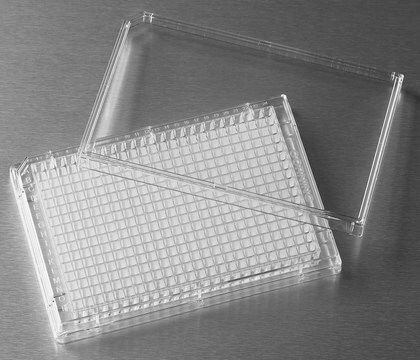CLS3571
Corning® 384 well microplate, low flange
Tissue Culture (TC)-treated surface, black polystyrene, flat bottom, sterile, lid, pack of 10
Synonym(s):
384 multiwell plates, 384 well low volume plates, 384 well microplates, 384 well microtiter plates, 384 well plates, 384 well tissue culture treated plates
About This Item
Recommended Products
material
black bottom
black polystyrene
flat bottom
polystyrene
square black wells
sterility
sterile
feature
lid
skirt
packaging
pack of 10
manufacturer/tradename
Corning 3571
maximum volume
112 μL
112 μL
size
384 wells
384 wells
working volume
80 μL
80 μL
color
black
binding type
Tissue Culture (TC)-treated surface
Looking for similar products? Visit Product Comparison Guide
General description
• Enhanced flatness provdes low intra- and inter- plate CV′s.
• Flat bottoms with 112μL total volume
• Conforms to standard microplate footprint and dimensions
• TC-treated for optimal cell attachment
• Nonreversable lids with condensation rings to reduce contamination
• Sterilized by gamma radiation and certified nonpyrogenic
• Ideal for today′s more sensitive assays and plate readers.
Legal Information
Certificates of Analysis (COA)
Search for Certificates of Analysis (COA) by entering the products Lot/Batch Number. Lot and Batch Numbers can be found on a product’s label following the words ‘Lot’ or ‘Batch’.
Already Own This Product?
Find documentation for the products that you have recently purchased in the Document Library.
Our team of scientists has experience in all areas of research including Life Science, Material Science, Chemical Synthesis, Chromatography, Analytical and many others.
Contact Technical Service





